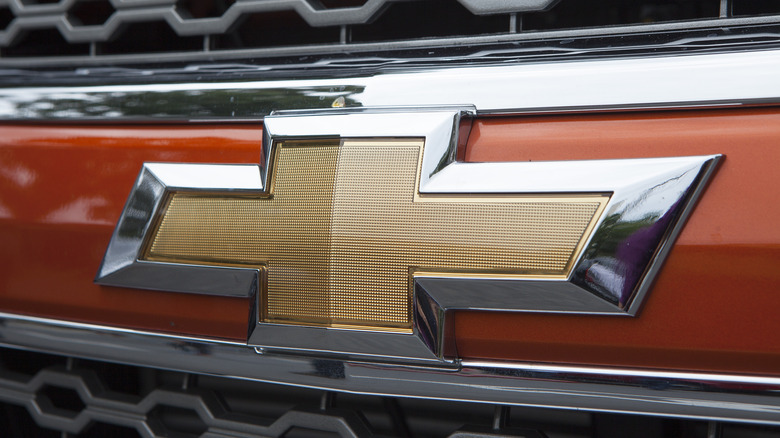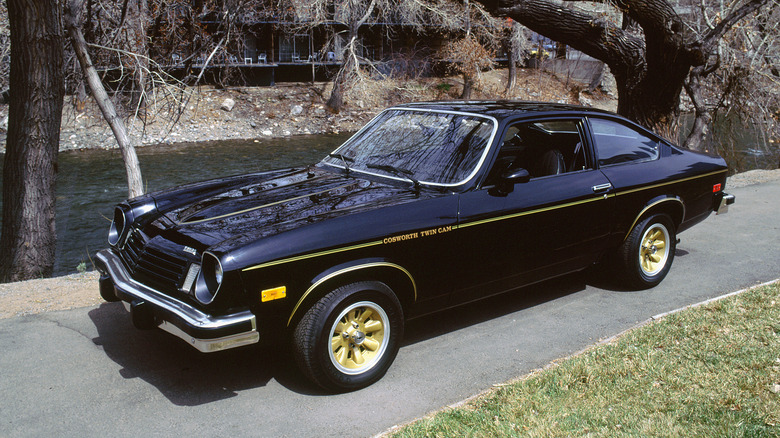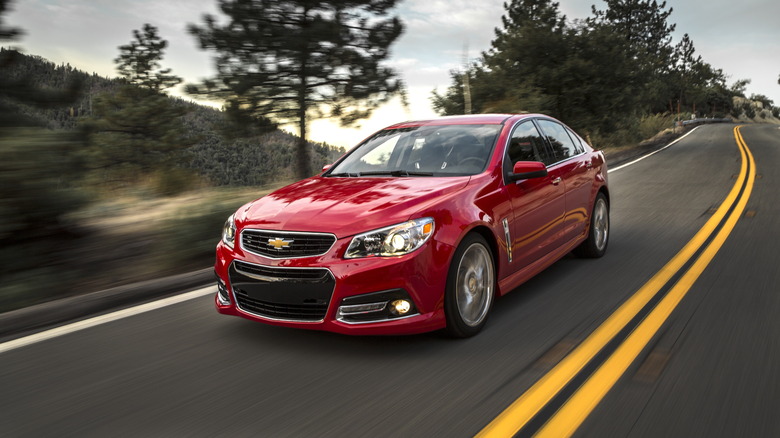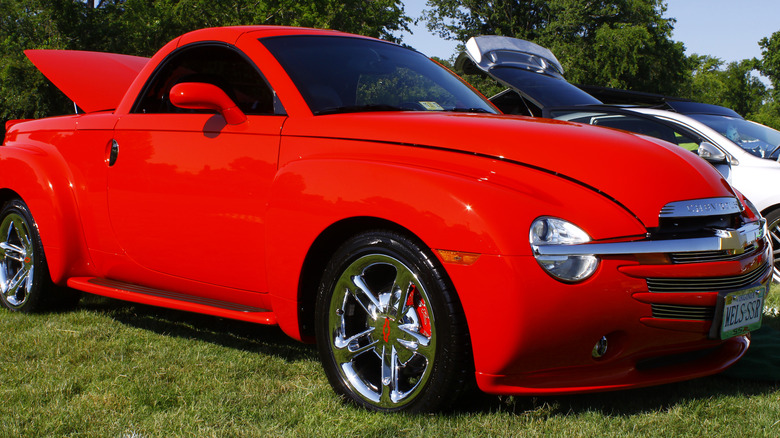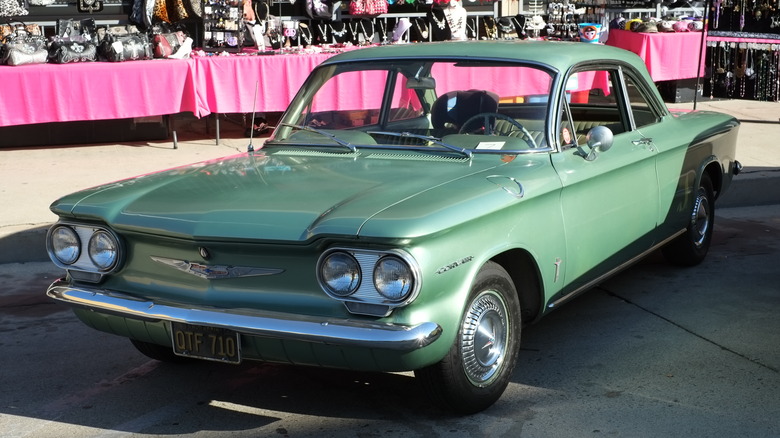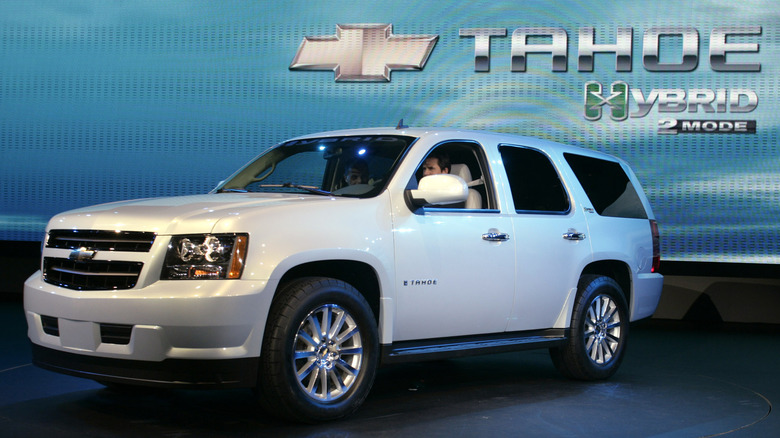Chevy's 5 Biggest Car Flops Of All Time
Chevy is one of the oldest and biggest automakers in the world. More than 4 million Chevy vehicles are sold in over 100 countries around the world every year (via Chevrolet). Also, Chevrolet is the best-selling brand under General Motors' umbrella.
Of course, it hasn't always been rainbows and butterflies. From having one of the best-selling cars in United States history (via Motor Trend) to its parent company (General Motors) filing for bankruptcy, Chevy has lived through its best and worst days.
Interestingly, according to data provided by GM Authority, Chevy sales in the U.S. domestic market have been declining since 2019 — but it's still doing well considering the demand. Even though we can't pinpoint the exact reason why Chevy's domestic sales have slowed down compared to the previous decade, we can go back in time and identify its biggest car flops of all time, or more succinctly, some of the most promising vehicles that were produced by Chevy but later discontinued due to poor sales or controversy.
Chevrolet Vega
In 1968, GM announced that it was working on a subcompact lightweight car made out of an aluminum engine that would be affordable and efficient to most consumers (via Motor Trend). The car was designated to be a game-changer that would bring GM back to its glory and overthrow the Ford Pinto and Volkswagen Beetle. True to its promise, GM unveiled the Chevrolet Vega in 1970 with a starting price of $2,090 (via New York Times). In fact, according to Hemmings, the Chevrolet Vega was well-received by the public and press when it was new to the market.
However, GM's success was short-lived when it recalled almost all of the Vega cars it had produced up to 1972. To be specific, the first recall was issued in April of 1971 for 130,000 Vega cars that could potentially blow up after the engine backfired. The second recall happened in May of 1971 after GM disclosed an engine component could disrupt the throttle linkage. Just when you thought it was over, GM then recalled 500,000 Chevrolet Vega cars in July 1972 because there was a problem with the rear axle — it was so bad that the rear axle could snap off the car.
Even after GM fixed the problems that caused the recalls, the Chevrolet Vega was still afflicted by rust on the body parts, excessive oil consumption, and overheating issues (via Popular Mechanics). In fact, if the engine was too hot, the coolant could leak and cause premature engine failure. In other words, the Chevrolet Vega was a piece of junk, and by the end of 1977, GM put it out of its misery. Even then, Popular Mechanics claims that some salvage yards didn't want anything to do with it.
Chevy SS
Have you ever heard of the Chevy SS? If you're confused, we're not talking about the Chevy Camaro SS, but the Chevy SS. But if you've heard, seen, or driven the Chevy SS, we can bet you've never seen a single advertisement for it. This is because Chevy kept it quiet and didn't run any ads to promote the vehicle, according to The Truth About Cars.
What is the real reason Chevy didn't market the Chevy SS? It has to do with the fact that the Chevy SS is an Australian import known as the Holden Commodore VF model that was introduced to the U.S. market (via Autoblog). As soon as it was shipped to dealers across the U.S., the General Motors brand in Australia (Holden) that was manufacturing the Chevy SS was planning to shut down its operation. Obviously, it didn't make sense for General Motors to advertise the Chevy SS while its Australian production plant was winding down its operations and it could only manufacture about 2,000 Chevy SS cars per year. Even the product chief of General Motors confirmed to Jalopnik that selling the Chevy SS was a tough job.
It's a shame the Chevy SS never gained traction (pun intended) considering it's probably most car enthusiasts' dream. It's a rear-wheel-drive sedan with a 6.2L V8 engine under the hood that can produce up to 415 horsepower. We can only speculate what could have happened if GM ramped up the production of the Chevy SS and advertised it aggressively.
Chevy SSR
The Chevy SSR (Super Sport Roadster) is one of those car flops that got most people asking "what the hell was GM thinking?" It was General Motors' failed attempt to make a hybrid vehicle that nobody asked for — a pickup, muscle car, and a convertible all rolled into one automobile.
Interestingly, when the Chevy SSR was first introduced to the public as a concept car, it received positive reviews. However, it didn't meet the expectations, and only 24,112 units were shipped out of the factory between 2003 and 2006. Even the Chevy SSR driving as the pace car during the 2003 Indianapolis 500 couldn't save it (via Autoweek).
What exactly happened? According to the New York Times, the Chevy SSR was too expensive for the average Joe. Why spend almost $50,000 on an unproven and radically designed new car when you could spend less to purchase reputable cars from the competitors? Even if you could afford it, the Chevy SSR was not known for its speed, space, or handling (via Hotcars). It also had a tendency to vibrate at high speeds, especially with the top down, as reported by The Truth About Cars.
Chevrolet Corvair
When the Chevrolet Corvair was first introduced, it was popular in the U.S. market considering that GM sold at least 200,000 units every year from 1960 to 1965, as confirmed by the Corvair Society of America. But everything came tumbling down in November 1965 when Ralph Nader's controversial book ("Unsafe at Any Speed") was published. The author dedicated the first chapter of the book to critique the Chevrolet Corvair (via New York Times).
Apparently, the Chevrolet Corvair had a suspension problem due to its rear-engine placement that made it susceptible to spinning out of control or rolling over. To put the final nail in its coffin, Ralph Nader also cautioned the readers from buying the Chevrolet Corvair since it had the highest number of accidents compared to any other vehicle on the road at the time. In fact, before Nader's book was published, General Motors had been served over 100 lawsuits related to the Chevrolet Corvair.
Of course, GM was not happy about the bad publicity — so much so that it hired private investigators to discredit Nader. But General Motor's top-secret mission was revealed when Nader testified to a Senate subcommittee in 1966. After his testimony, Congress enacted the National Traffic and Motor Vehicle Safety Act that same year. Its governing agency, the NHTSA (National Highway Traffic Safety Administration) was later established in 1970.
As expected, General Motors struggled to sell the Chevrolet Corvair after the negative publicity — it sold less than 50,000 units from 1967 until its final year of production in 1969.
Chevrolet Tahoe Hybrid
Back in 2007, the price of gasoline had soared to a record high in the U.S. (via CNN Money). In effect, the market was ripe for hybrid vehicles with low fuel consumption, and General Motors took the opportunity to introduce the Chevrolet Tahoe Hybrid SUV. It was designed with a 6L V8 engine combined with dual electric motors and a 300-volt battery (via Motor Trend). This means that drivers had the option to alternate between gasoline and electricity to improve fuel economy.
Nevertheless, the Chevrolet Tahoe Hybrid was a flop, and it was canceled in 2013 (via AutoTrader). As reported by Motor Biscuit, one of the biggest reasons why the Tahoe hybrid failed was because it was too expensive. Not to mention, most people were holding their pockets too tight during the recession to afford a $50,000 SUV.
The only advantage the Tahoe Hybrid had over the gasoline model was that its fuel economy had improved by 30% to 21 miles per gallon — up from 16 mpg. Then again, the standard Tahoe LS was cheaper with a starting price of $36,500. And if saving gas was a priority during the recession, why would you choose an expensive hybrid SUV with 21 mpg when you could buy cheaper hybrid vehicles like the Toyota Prius that could deliver up to 48 mpg? Well, it doesn't make sense!
